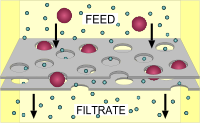
Photo from wikipedia
The standard bottom-up proteomic workflow is comprised of sample preparation, data acquisition, and data analysis. While the latter two parts have made considerable advances in the last decade, sample preparation… Click to show full abstract
The standard bottom-up proteomic workflow is comprised of sample preparation, data acquisition, and data analysis. While the latter two parts have made considerable advances in the last decade, sample preparation has remained an important challenge within the workflow due to the multi-step nature of complex biological samples, and still requires much development. Several sample preparation methods have been developed and used in the last two decades, including in-gel, in-solution, on-bead, filter-aided sample preparation, and suspension trapping, to improve reproducibility, efficiency, scalability, and reduce handling time of this process. One of the most recent methods developed and applied in proteomics studies in recent years is suspension trapping, which combines rapid detergent removal, reactor-type protein digestion, and peptide clean-up in a tip or spin column. Suspension trapping is a simple, rapid, and reproducible digestion method that can effectively handle proteins in low microgram or sub-microgram amounts. This review discusses the benefits of the suspension trapping digestion method in relation to its development and application in bottom-up proteomics studies. We also discuss recent applications of suspension trapping digestion to different sample types and the features of the suspension trapping digestion method compared with other sample preparation methods. This article is protected by copyright. All rights reserved.
Journal Title: Journal of separation science
Year Published: 2022
Link to full text (if available)
Share on Social Media: Sign Up to like & get
recommendations!